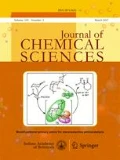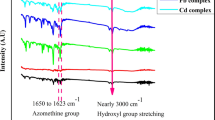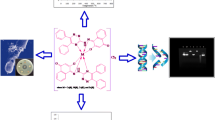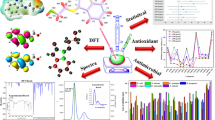Abstract
The 12-membered Schiff base macrocyclic complexes, [Dichloro [5,6;11,12-dibenzophenone-1,4,7,10-tetraazacyclododeca-1,3,7,9-tetraene-2,3,8,9-diindole] metal(II) [M = Co(II), 1; Ni(II), 2; Cu(II), 3 and Zn(II), 4] were synthesized via template condensation of isatin and 3,4-diaminobenzophenone. These four complexes were characterized employing the analytical, spectral viz., FTIR, NMR, Mass, UV-Vis, EPR, TGA/DTA and SEM. The formation of metal complexes has been confirmed on account of the characteristic band positions in FTIR spectra and resonance signals in NMR spectra while the absorption bands in UV-Vis spectra and magnetic moment analysis signify the geometry of the complexes. However, the EPR study inferred distorted octahedral geometry in Cu(II) complex. The binding profile of the metal complexes (1–4) with CT-DNA was monitored by fluorescence and circular dichroism (CD) spectroscopy coupled with molecular docking studies. The binding constants were found to be highest for complex 3. Further, the hypothesis of preferential binding in the minor groove of double-stranded DNA is supported by CD and docking results. The antioxidative properties showed substantial radical scavenging potency of the complex 3. The comparative in vitro antibacterial study of the metal complexes against different pathogenic microbes (S. aureus, E. coli and C. albicans) revealed enhanced activity for complex 3 which is further certified by its efficacy to resist biofilm formation as investigated by XTT reduction assay.
Graphical Abstract
SYNOPSIS 12-membered Schiff base macrocyclic complexes (1–4) were synthesized via template condensation of isatin and 3,4-diaminobenzophenone and the binding mode of complexes with CT-DNA was divulged through the fluorescence and circular dichroism studies. Molecular docking studies are reported for complexes 3 and 4. In addition, the pharmacological efficacy of the newly synthesized complexes was explored by examining their antioxidant, antimicrobial, antibiofilm activities.





Similar content being viewed by others
References
Bayri A and Karakaplan M 2007 Theoretical approach to the magnetic properties of Mn(II), Cr(III) and Cu(II) complexes in the newly reported 12- and 15-membered macrocyclic ligands Pramana-J. Phys. 69 301
(a) Liu C M, Xiong G, You X Z and Liu Y J 1996 Crystal structure and some properties of a novel potent \(\text{Cu}_{2}\text{ Zn }_{2}\text{ SOD }\) model schiff base copper(II) complex \(\{[\text{ Cu(bppn) }](\text{ ClO }_{4})_{2}\}_{2}.\text{ H }_{2}\text{ O }\) Polyhedron 15 4565; (b) West D X, Liberia E, Padhye S B, Chikate R C, Sonawane P B, Kumar A S and Yeranda R S 1993 Thiosemicarbazone complexes of copper(II): structural and biological studies Coord. Chem. Rev. 123 49; (c) Holla B S, Veeredra B, Shivanda M K and Poojar B 2003 Synthesis characterization and anticancer activity studies on some Mannich bases derived from 1, 2, 4-triazoles Eur. J. Med. Chem. 38 759; (d) Priya N P, Arunachalam S, Manimaran A, Muthupriya D and Jayabalakrishnan C 2009 Mononuclear Ru(III) Schiff base complexes: Synthesis, spectral, redox, catalytic and biological activity studies Spectrochim. Acta A 72 670
Singh D P, Malik V, Kumar K, Sharma C and Aneja K R 2010 Macrocyclic metal complexes derived from 2,6-diaminopyridine and isatin with their antibacterial and spectroscopic studies Spectrochim. Acta A 76 45
(a) Singh D P, Parveen R Kumar R Surain P and Aneja K R 2014 Spectroscopic and antimicrobial studies of macrocyclic metal complexes derived from 1,8-diaminonaphthalene and dimedone J. Incl. Phenom. Macro. 78 363; (b) Gerbeleu N V, Arion V B and Burges J 1999 Template Synthesis of Macrocyclic Compounds (Weinheim: Wiley-VCH)
(a) Shakir M, Bano N, Rauf A, Kazmi S and Alam M 2017 Synthesis and characterization of pharmacologically active 18-membered tetraamide macrocyclic complexes of Mn(II), Co(II), Ni(II), Cu(II), and Zn(II): In-vitro antimicrobial, anticancer screening, DNA interaction and docking studies Inorg. Nano-Met. Chem. 47 576; (b) Raman N 2009 Synthesis, spectral characterization, in-vitro antimicrobial evaluation and DNA cleavage studies of few macrocyclic complexes J. Indian Chem. Soc. 86 1143
Sakyan I, Logoglu E, Arslan S, Sari N and Sakiyan N 2004 Antimicrobial activities of N-(2-hydroxy-1-naphthalidene)-amino acid (glycine, alanine, phenylalanine, histidine, tryptophane) Schiff bases and their manganese(III) complexes Biometals 17 115
Maimon E, Zilbermann I, Golub G, Ellern A, Shames A I, Cohen H A and Meyerstein D 2001 Comproportionation and redox catalyzed isomerization of Cu(II) (1R,4S,8R,11S-1,4,8,11-tetramethyl-1,4,8,11-tetraazacyclotetradecane)\(^{2+}\) in aqueous solutions Inorg. Chim. Acta 324 65
Kidwai M, Jahan A and Mishra N K 2014 Isatins: a diversity orientated biological profile Med. Chem. 4 451
Bhrigu B, Pathak D, Siddiqui N, Alam M S and Ahsan W 2010 Search for Biological Active Isatins: A Short Review Int. J. Pharm. Sci. Drug Res. 2 229
Walsh O M, Meegan M J, Prendergast R M and Nakib T A 1996 Synthesis of 3-acetoxyazetidin-2-ones and 3-hydroxyazetidin-2-ones with antifungal and antibacterial activity Eur. J. Med. Chem. 31 989
(a) Sharma K, Parveen, Singh D P and Chopra R 2015 Antibacterial and spectroscopic studies of biologically active macrocyclic complexes of divalent metal ions Der Pharma Chem. 7 292; (b) Singh D P, Grover V, Kumar K and Jain K 2011 Synthesis and characterization of divalent metal complexes of the macrocyclic ligand derived from isatin and 1,2-diaminobenzene J. Serb. Chem. Soc. 76 385
Singh D P, Kumar K and Sharma C 2010 New 14-membered octaazamacrocyclic complexes: Synthesis, spectral, antibacterial and antifungal studies Eur. J. Med. Chem. 45 1230
Pisoschi A M, Cheregi M C and Danet A F 2009 Total antioxidant capacity of some commercial fruit juices: electrochemical and spectrophotometrical approaches Molecules 14 480
(a) Biradar J S, Sasidhar B S and Parveen R 2010 Synthesis, antioxidant and DNA cleavage activities of novel indole derivatives Eur. J. Med. Chem. 45 4074; (b) Valko M, Leibfritz D, Moncol J, Cornin M T, Mazur M and Telser J 2007 Free radicals and antioxidants in normal physiological functions and human disease Int. J. Biochem. Cell Biol. 39 44; (c) Fernandes A S, Gaspar J, Cabral M F, Caneiras C, Guedes R, Rueff J, Castro M, Costa J and Oliveira N G 2007 Macrocyclic copper(II) complexes: Superoxide scavenging activity, structural studies and cytotoxicity evaluation J. Inorg. Biochem. 101 849
Sasikumar J M, Patharaj J, Adithya E S, Christabel P H and Shamna R 2012 Antioxidant capacity and phenolic content of Elaeagnus kologa schlecht. An underexploited fruit from India Free Radicals Antioxid. 2 28
Agrawal S, Kulkarni G T and Sharma V N 2011 A comparative study on the antioxidant activity of methanolic extracts of Terminalia paniculata and Madhuca longifolia Free Radicals Antioxid. 1 62
Krug M and Hilgeroth A 2008 Recent advances in the development of Multi-Kinase Inhibitors Mini-Rev. Med. Chem. 8 1312
(a) Motzer R J, Hutson T E, Tomczak P, Michaelson M D, Bukowski R M, Rixe O, Oudard S, Negrier S, Szczylik C and Kim S T 2007 Sunitinib versus Interferon Alfa in Metastatic Renal-Cell Carcinoma New Engl. J. Med. 356 115; (b) Xiang Q, Wang F, Su X, Liang Y, Zheng L, Mi Y, Chen W and Fu L 2011 Effect of BIBF 1120 on reversal of ABCB1-mediated multidrug resistance Cell. Oncol. 34 33
O’Donnell F, Smyth T, Ramachandran V and Smyth W 2010 A study of the antimicrobial activity of selected synthetic and naturally occurring quinolines Int. J. Antimicrob. Ag. 35 30
Stewart P and Costernon J 2001 Antibiotic resistance of bacteria in biofilms. Lancet 358 135
Panwar R, Pemmaraju S C, Sharma A K and Pruthi V 2016 Efficacy of ferulic acid encapsulated chitosan nanoparticles against Candida albicans biofilm Microb. Pathog. 95 21
Lewis K 2001 Riddle of biofilm resistance Antimicrob. Agents Chemother. 45 999
Mah T F and O’Toole G A 2001 Mechanisms of biofilm resistance to antimicrobial agents Trends Microbiol. 9 34
Frank J F 2001 Microbial attachment to food and food contact surfaces Adv. Food Nutr. Res. 43 319
Kojic E M and Darouiche R O 2004 Candida infections of medical devices Clin. Microbiol. Rev. 17 255
Hawser S P and Douglas L J 1994 Biofilm formation by Candida species on the surface of catheter materials in-vitro Infect. Immun. 62 915
Aendekerk S, Diggle S P, Song Z, Høiby N, Cornelis P, Williams P and Ca’mara M 2005 The MexGHI-OpmD multidrug efflux pump controls growth, antibiotic susceptibility and virulence in Pseudomonas aeruginosa via 4-quinolone-dependent cell-to-cell communication Microbiology 151 1113
Hong J, Jiao Y, Yan J, He W, Guo Z, Zhu L and Zhang J 2010 DNA cleavage promoted by trigonal-bipyramidal zinc(II) and copper(II) complexes formed by asymmetric tripodal tetradendate 2-[bis(2-aminoethyl)amino]ethanol Inorg. Chim. Acta 363 793
Huang K B, Chen Z F, Liu Y C, Li Z Q, Wei J H, Wang M, Xie X L and Liang H 2013 Platinum(II) complexes containing aminophosphonate esters: Synthesis, characterization, cytotoxicity and action mechanism Eur. J. Med. Chem. 64 554
Huang, R, Wallqvist A and Covell D G 2005 Anticancer metal compounds in NCI’s tumor-screening database: putative mode of action Biochem. Pharmacol. 69 1009
Ranford J D, Sadler P J and Tocher D A 1993 Cytotoxicity and antiviral activity of transition-metal salicylato complexes and crystal structure of Bis(diisopropylsalicylato) (l,l0-phenanthroline)copper(II) Dalton Trans. 22 3393
Li Y, Yang Z Y and Wang M F 2009 Synthesis, characterization, DNA binding properties and antioxidant activity of Ln(III) complexes with hesperetin-4-one-(benzoyl) hydrazone Eur. J. Med. Chem. 44 4585
Pravin N and Raman N 2014 Investigation of in-vitro anticancer and DNA strap interactions in live cells using carboplatin type Cu(II) and Zn(II) metalloinsertors Eur. J. Med. Chem. 85 675
Shakir M, Hanif S, Sherwani M A, Owais M, Azam M and Resayes S I A 2016 Pharmacophore hybrid approach of new modulated bis-diimine \(\text{ Cu }^{{\rm II}}/ \text{ Zn }^{{\rm II}}\) complexes based on 5-chloro Isatin Schiff base derivatives: Synthesis, spectral studies and comparative biological assessment J. Photochem. Photobiol. B 157 39
Ramos-Sanchez M C, Rey F J, Rodriguez M L, Martin-Gil F J and Martin-Gil 1988 DTG and dta studies on typical sugars J. Thermochim. Acta 134 55
Alaghaz A N M A and Ammar R A 2010 New dimeric cyclodiphosph(V) azane complexes of Cr(III), Co(II), Ni(II), Cu(II), and Zn(II): Preparation, characterization and biological activity studies Eur. J. Med. Chem. 45 1314
Seth B K, Ray A, Saha A, Saha P and Basu S 2014 Potency of photoinduced electron transfer and antioxidant efficacy of pyrrole and pyridine based Cu(II)-Schiff complexes while binding with CT-DNA J. Photochem. Photobiol. B 132 72
Kavitha P, Saritha M and Reddy K L 2013 Synthesis, structural characterization, fluorescence, antimicrobial, antioxidant and DNA cleavage studies of Cu(II) complexes of formyl chromone Schiff bases Spectrochim. Acta A 102 159
El-Sonbati A Z, Diab M A, El-Bindarya A A, Ghoneim M M, Mohesien M T and Abd El-Kader M K 2016 Polymeric complexes-LXI. Supramolecular structure, thermal properties, SS-DNA binding activity and antimicrobial activities of polymeric complexes of rhodanine hydrazone compounds J. Mol. Liq. 215 711
Sheikhshoaie I, Ebrahimipour S Y, Lotfi N, Mague J T and Khaleghi M 2016 Synthesis, spectral characterization, X-ray crystal structure and antimicrobial activities of two cis dioxido-vanadium(V) complexes incorporating unsymmetrical dimalonitrile-based (NNO) Schiff base ligands Inorg. Chim. Acta 442 151
Mares D 1989 Electron microscopy of Microsporum cookei after ‘in-vitro’ treatment with protoanemonin: A combined SEM and TEM study Mycopathologia 108 37
(a) Siddiqi Z A, Khan M, Khalid M and Kumar S 2007 Spectral and electrochemical characterization of bimetallic complexes of a novel 32-membered unsymmetrical [\(\text{ N }_{12}\)] macrocycle Transition Met. Chem. 32 927; (b) Athappan P R and Rajagopal G 1996 Synthesis, spectroscopic and redox behaviour of copper(II), nickel(II) and cobalt(II) complexes of some macrocyclic multidentates Polyhedron 15 527
Singh A K, Singh R and Saxena P 2004 Macrocyclic metal complexes: synthesis and characterization of 14- and 16- membered tetraaza macrocyclic complexes of transition metals Transition Met. Chem. 29 867
Casas J S, Castellano E E, Tasende M S G, Sanchez A and Sordo J 2000 Reaction of dimethylthallium(III) acetate and isatin-3-thiosemicarbazone. Crystal and molecular structure of dimethyl (dimethylsulfoxide) (isatin-3-thiosemicarbazonato) thallium(III) Inorg. Chim. Acta 304 283
Asadi M, Sepehrpour H and Mohammadi K 2011 Tetradentate Schiff base ligands of 3,4-diaminobenzophenone: Synthesis, characterization and thermodynamics of complex formation with Ni(II), Cu(II) and Zn(II) metal ions J. Serb. Chem. Soc. 76 63
Aqra F M A M 1999 New macrocyclic complexes containing amide, imine and secondary amine functions Transition Met. Chem. 24 337
Labisbal E, Sousa A, Castineiras A, Vazquez J A G, Romero J and West D X 2000 Spectral and structural studies of metal complexes of isatin 3-hexamethyleneiminylthiosemicarbazone prepared electrochemically Polyhedron 19 1255
Rahaman F and Mruthyunjayaswamy B H M 2014 Synthesis, spectral characterization and biological activity studies of transition metal complexes of Schiff base ligand containing indole moiety Complex Met. 1 88
Niasari M S and Amiri A 2006 Synthesis and characterization of Bis(macrocyclic) Nickel(II) complexes containing aromatic nitrogen-nitrogen linkers produced by template condensation Transition Met. Chem. 31 157
Raman N and Thangaraja C 2005 Synthesis and structural characterization of a fully conjugated macrocyclic tetraaza (14)-membered Schiff base and its bivalent metal complexes Transition Met. Chem. 30 317
Menteşe E 2013 Efficient microwave assisted synthesis of some new benzimidazoles containing the mebendazole nucleus J. Chem. Res. 37 168
Haribabu J, Subhashree G R, Saranya S K, Gomathi R, Karvembu and Gayathri D 2016 Isatin based thiosemicarbazone derivatives as potential bioactive agents: anti-oxidant and molecular docking studies J. Mol. Struct. 1110 185
Yousif E, Majeed A, Sammarrae K A, Salih N, Salimon J and Abdullah B Metal complexes of Schiff base: Preparation, characterization and antibacterial activity Arab. J. Chem. https://doi.org/10.1016/j.arabjc.2013.06.006.
Sahin D, Koçoglu S, Sener O, Senol C, Dal H, Hokelek T and Hayval Z 2015 New NO donor ligands and complexes containing furfuryl or crown ether moiety: Syntheses, crystal structures and tautomerism in ortho-hydroxy substituted compounds as studied by UV-vis spectrophotometry J. Mol. Struct. 1102 302
(a) Omar M M and Mohamed G G 2005 Potentiometric, spectroscopic and thermal studies on the metal chelates of 1-(2-thiazolylazo)-2-naphthalenol Spectrochim. Acta A 61 929; (b) Lever A B P 1968 Inorganic Electronic Spectroscopy 1st edn. (Amsterdam: Elsevier); (c) Chandra S and Pundir M 2007 Spectral studies of cobalt(II) complexes of 12-membered macrocyclic ligands having thiosemicarbazone moieties Spectrochim. Acta A 68 883
Figgis B 2000 Ligand field theory and its applications 1st edn. (New York: John-Wiley)
Siddiqi Z A, Siddique A, Shahid M, Sharma P K, Khalid M and Yogi A 2013 Synthesis and characterization of homo-dinuclear complexes \([\text{ M }_{2}(\text{ dea })_{2}(\text{ H }_{2}\text{ O })_{4}], [\text{ M }_{2}(\text{ dea })_{2}(\text{ Bipy })_{2}]\) and \([\text{ Fe }_{2}(\text{ dea })_{2}(\text{ H }_{2}\text{ O })_{2}(\text{ Cl })_{2}]\) \((\text{ M }=\text{ Co }\), Ni or Cu; \(\text{ H }_{2}\text{ dea }=\text{ diethanolamine })\): \(^{57}\)Fe Mössbauer and electrochemical investigations J. Mol. Struct. 1036 209
(a) Kivelson D and Neiman R 1962 ESR studies on the bonding in copper complexes J. Chem. Phys. 35 149; (b) Garribba E and Micera G 2006 The determination of the geometry of Cu(II) complexes: An EPR spectroscopy experiment J. Chem. Educ . 83 1229; (c) Raman N, Thangaraja C and Johnsonraja S 2005 Synthesis, spectral characterization, redox and antimicrobial activity of Schiff base transition metal(II) complexes derived from 4-aminoantipyrine and 3-salicylideneacetylacetone Cent. Eur. J. Chem. 3 537
Kneubuhl F K 1960 Line shapes of electron paramagnetic resonance signals produced by powders, glasses, and viscous liquids J. Chem. Phys. 33 1074
Proctor I M, Hathaway B J and Nicholls P 1968 The electronic properties and stereochemistry of the copper(II) ion. Part I. Bis(ethylenediamine)copper(II) complexes J. Chem. Soc. (A) 1678; (b) Ray A, Rosair G M, Kadam R and Mitra S 2009 Three new mono-di-trinuclear cobalt complexes of selectively and non-selectively condensed Schiff bases with \(\text{ N }_{2}\text{ O }\) and \(\text{ N }_{2}\text{ O }_{2}\) donor sets: Syntheses, structural variations, EPR and DNA binding studies Polyhedron 28 796; (c) Chandra S and Gupta L K 2005 Spectroscopic studies on Co(II), Ni(II) and Cu(II) complexes with a new macrocyclic ligand: 2,9-dipropyl-3,10-dimethyl-1,4,8,11-tetraaza-5,7:12,14-dibenzocyclotetradeca-1,3,8,10-tetraene Spectrochim. Acta A 61 1181
Sharma S, Athar F, Maurya M R, Naqvi F and Azam A 2005 Novel bidentate complexes of Cu(II) derived from 5-nitrofuran-2-carboxaldehyde thiosemicarbazones with antiamoebic activity against E. histolytica Eur. J. Med. Chem. 40 557
Pandya J H, Jadeja R N and Ganatra K J 2014 Spectral characterization and biological evaluation of Schiff bases and their mixed ligand metal complexes derived from 4,6-diacetylresorcinol J. Saudi Chem. Soc. 18 190
Khan M I, Khan A, Hussain I, Khan M A, Gul S, Iqbal M, Rahman I U and Khuda F 2013 Spectral, XRD, SEM and biological properties of new mononuclear Schiff base transition metal complexes Inorg. Chem. Commun. 35 104
Ramachandran E, Raja D S, Bhuvanesh N S P and Natarajan K 2012 Mixed ligand palladium(II) complexes of 6-methoxy-2-oxo-1,2-dihydroquinoline-3-carbaldehyde 4N-substituted thiosemicarbazones with triphenylphosphine co-ligand: Synthesis, crystal structure and biological properties Dalton Trans. 41 13308
Li Y, Wu Y, Zhao J and Yang P 2007 DNA-binding and cleavage studies of novel binuclear copper(II) complex with 1,10 -dimethyl-2,20 -biimidazole ligand J. Inorg. Biochem. 101 283
Xi P X, Xu Z H, Liu X H, Chen F J and Zeng Z Z 2008 Synthesis, characterization, antioxidant activity, and DNA-binding studies of 1-cyclohexyl-3-tosylurea and its Nd(III), Eu(III) complexes Chem. Pharm. Bull. 56 541
Chen H, Ahsan S S, Berrios M B S, Abruna H D and Webb W W 2010 Mechanisms of quenching of Alexa fluorophores by natural amino acids J. Am. Chem. Soc. 132 7244
Sarwar T, Rehman S U, Husain M A, Ishqi H M and Tabish M 2015 Interaction of coumarin with calf thymus DNA: Deciphering the mode of binding by in vitro studies Int. J Biol. Macromol. 73 9
(a) Song G, Yan Q and He Y 2005 Studies on Interaction of Norfloxacin, \(\text{ Cu }^{2+}\), and DNA by Spectral Methods J. Fluoresc. 15 673; (b) Asatkar A K, Tripathi M, Panda S, Pande R and Zade S S 2017 Cu(I) complexes of bis(methyl)(thia/selena) salen ligands: Synthesis, characterization, redox behavior and DNA binding studies Spectrochim. Acta A 171 18
(a) LePecq J B and Paoletti C 1967 A fluorescent complex between ethidium bromide and nucleic acids: Physical-Chemical characterization J. Mol. Biol. 27 87; (b) Kumar B V, Naik H S B, Girija D, Sharath N, Pradeepa S M, Hoskeri H J and Prabhakara M C 2012 Synthesis, DNA-binding, DNA-photonuclease profiling and antimicrobial activity of novel tetra-aza macrocyclic Ni(II), Co(II) and Cu(II) complexes constrained by thiadiazole Spectrochim. Acta A 94 192
Kumar P, Baidya B, Chaturvedi S K, Khan R H, Manna D and Mondal B 2011 DNA binding and nuclease activity of copper(II) complexes of tridentate ligands Inorg. Chim. Acta 376 264
(a) Rajendran A and Nair B U 2006 Unprecedented dual binding behaviour of acridine group of dye: A combined experimental and theoretical investigation for the development of anticancer chemotherapeutic agents Biochim. Biophys. Acta 1760 1794; (b) Shahabadi N, Kashanian S and Darabi F 2010 DNA binding and DNA cleavage studies of a water soluble cobalt(II) complex containing dinitrogen Schiff base ligand: the effect of metal on the mode of binding Eur. J. Med. Chem. 45 4239
Maheswari P U and Palaniandavar M 2004 DNA binding and cleavage properties of certain tetrammine ruthenium(II) complexes of modified 1,10-phenanthrolines-effect of hydrogen bonding on DNA-binding affinity J. Inorg. Biochem. 98 219
(a) Bindu P, Kurup M R P and Satyakeerty T R 1998 EPR, cyclic voltammetric and biological activities of copper(II) complexes of salicylaldehyde N(4)-substituted thiosemicarbazone and heterocyclic bases Polyhedron 18 321; (b) Singh R P, Murthy K C N and Jayaprakasha G K 2002 Studies on the antioxidant activity of pomegranate (Punica granatum) peel and seed extracts using in vitro models J. Agric. Food Chem. 50 81
(a) John R P, Sreeknth A, Rajakannan V, Ajith T A and Kurup M R P 2004 New copper(II) complexes of 2-hydroxyacetophenone \(N\)(4)-substituted thiosemicarbazones and polypyridyl co-ligands: structural, electrochemical and antimicrobial studies Polyhedron 23 2549; (b) Ravichandran J, Gurumoorthy P, Karthick C and Kalilur Rahiman A 2014 Mononuclear zinc(II) complexes of 2-((2-(piperazin-1-yl)ethylimino) methyl)-4-substituted phenols: Synthesis, structural characterization, DNA binding and cheminuclease activities J. Mol. Struct. 1062 147
Kesavan M P, Kumar G G V, Raja J D, Anitha K, Karthikeyan S and Rajesh J 2017 DNA interaction, antimicrobial, antioxidant and anticancer studies on Cu(II) complexes of Luotonin A J. Photochem. Photobiol. B 167 20
Corbin B D, Seeley E H, Raab A, Feldmann J, Miller M R, Torres V J K L, Anderson, Dattilo, B. M, Dunman, P M, Gerads R, Caprioli, R M, Nacken W, Chazin W J and Skaar E P 2008 Metal chelation and inhibition of bacterial growth in tissue abscesses Science 319 962
Nitha L P, Aswathy R, Mathews N E, Kumari B S and Mohanan K 2014 Synthesis, spectroscopic characterisation, DNA cleavage, superoxidase dismutase activity and antibacterial properties of some transition metal complexes of a novel bidentate Schiff base derived from isatin and 2-aminopyrimidine Spectrochim. Acta A 118 154
Chohan Z H, Pervez H, Rauf A, Khan K M and Supuran C T 2004 Isatin-derived Antibacterial and Antifungal Compounds and their Transition Metal Complexes J. Enzyme Inhib. Med. Chem. 19 417
Mohanan K, Devi S N and Murukan B 2006 Complexes of Copper(II) with 2-(N-Salicylideneamino)-3-carboxyethyl-4,5,6,7-tetrahydrobenzo[b] thiophene Containing Different Counter Anions Syn. React. Inorg. Met. Org. Nano-Met. Chem. 36 441
Sherwani M A, Tufail S, Khan A A and Owais M Gold Nanoparticle-Photosensitizer Conjugate Based Photodynamic Inactivation of Biofilm Producing Cells: Potential for Treatment of C. albicans Infection in BALB/c Mice PLoS ONE. https://doi.org/10.1371/journal.pone.0131684 July 6, 2015
Filosa R, Peduto A, Micco S D, Caprariis P D, Festa M, Petrella A, Capranico G and Bifulco G 2009 Molecular modelling studies, synthesis and biological activity of a series of novel bisnaphthalimides and their development as new DNA Topoisomerase II inhibitors Bioorgan. Med. Chem. 17 13
Corradini R, Sforza S, Tedeshi T and Marchelli R 2007 Chirality as a tool in nucleic acid recognition: Principles and relevance in biotechnology and in medicinal chemistry Chirality 19 269
Acknowledgements
Authors are thankful to the Professor M. Shakir, Chairman, Department of Chemistry, Aligarh Muslim University, Aligarh, India for providing necessary facilities for research. Authors are highly indebted to the Punjab University Chandigarh for providing CHN analysis, NMR and ESI-Mass spectra and IIT Guwahati for EPR studies. Nausheen Bano is thankful to University Grants Commission (UGC) for financial assistance. The facilities given to the department under SAP-DRS-II, FIST and PURSE programs are highly acknowledged.
Author information
Authors and Affiliations
Corresponding author
Electronic supplementary material
Below is the link to the electronic supplementary material.
Rights and permissions
About this article
Cite this article
Shakir, M., Bano, N., Rauf, M.A. et al. Pharmacologically significant tetraaza macrocyclic metal complexes derived from isatin and 3,4-diaminobenzophenone: Synthesis, spectral studies and comparative in vitro biological assessment. J Chem Sci 129, 1905–1920 (2017). https://doi.org/10.1007/s12039-017-1398-8
Received:
Revised:
Accepted:
Published:
Issue Date:
DOI: https://doi.org/10.1007/s12039-017-1398-8




